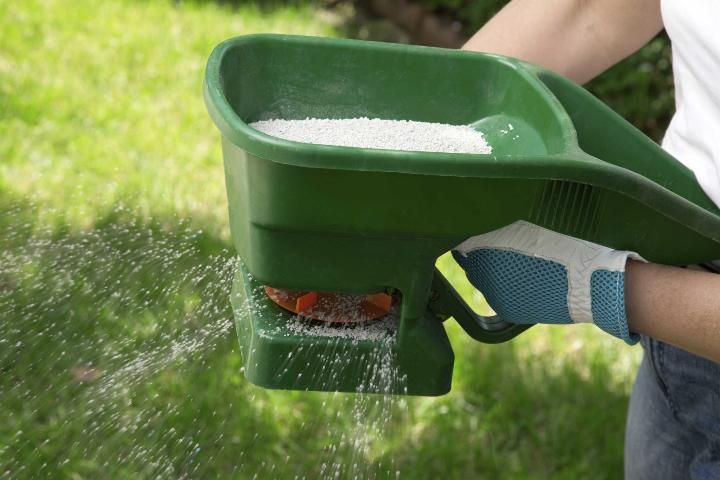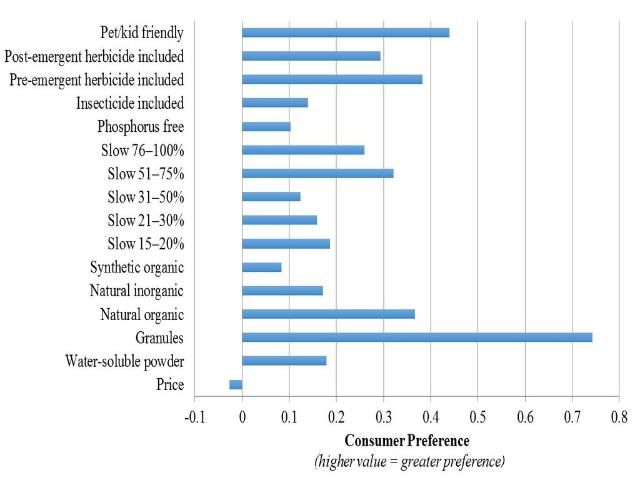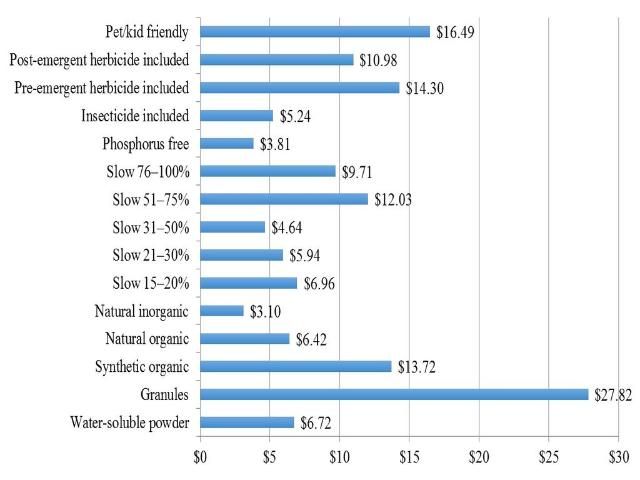Introduction
Lawn fertilizers are an important part of healthy lawn maintenance. A healthy lawn benefits the environment (through urban heat dissipation, erosion control, carbon sequestration, and water quality), the community (enhanced safety and value), and private property (improved property value and aesthetics) (Yue et al. 2012). More than 75% of US homes (approximately 53 million acres) have lawns (Kiesling and Manning 2010). Consequently, there is a large market for home lawn fertilizers. A large market and wide variety of site-specific requirements have spurred the development of several different fertilizer products and product features from which consumers can choose. Industry stakeholders and educators must understand consumer preferences in this market. Consumer preference influences product selection; understanding consumer preference helps the industry to design appealing products and to educate consumers effectively to promote those products. Knowing consumer preferences greatly reduces stakeholders' risks and improves efficiency as they assess their current offerings and determine their future product and promotional strategies. Consumer preferences are not always informed and do not always align with best practices. Understanding the disconnect will help turf industry educators better address consumers' misperceptions about fertilizers.

Credit: Bochkarev Photography, iStock/Thinkstock
The following report discusses the findings of a 2013 survey of 1,066 US homeowners about their preferences and willingness-to-pay for various lawn fertilizer attributes. Attributes include price (per 25-pound bag), type (liquid, water-soluble powder, granules/pelleted), source (natural organic, synthetic organic, natural inorganic, synthetic organic), nitrogen-release rate (fast [<15%] and five levels of slow release [15–20%, 21–30%, 31–50%, 51–75%, 76–100%]), phosphorus content (phosphorus-free, contains phosphorus), herbicide content (pre-emergent, post-emergent, none), insecticide content (present, absent), and pet/kid friendly (labeled, not labeled). Respondents were provided definitions of source, nitrogen-release rate, phosphorus content, and herbicide content before the choice experiment (Table 1).
A choice experiment was used to assess homeowner preferences and to determine their willingness to pay for fertilizers. In the choice experiment, respondents were given two lawn fertilizer products with different attributes to examine. They were asked to choose one of three purchase options: product 1, product 2, or neither product. Survey results indicated how different fertilizer attributes influence consumer choice/preference of lawn fertilizers. Only homeowners who had lawns and were the primary decision makers for those lawns participated in the survey. Respondents were recruited from all 48 US contiguous states, with 59% living in the suburbs, 21% living in rural areas, and 20% living in urban areas. Statistics for the respondents showed that the average age was 49 years old, 51% were male, 81% were white/Caucasian, 45% had a four-year college degree or higher, 64% had pets with lawn access, and 39% had minor children (<18 years old) living at home. The mean household size was between two and three people, and the mean household income was between $40,000 and $59,999 per year.
Important Lawn Fertilizer Attributes
According to the survey results, the only attribute that negatively influenced homeowner preferences for lawn fertilizers was price (Figure 1), which was consistent with the typical price and quantity demanded relationship (i.e., consumers were less likely to select higher-priced lawn fertilizers). Fertilizer type strongly influenced consumers' fertilizer selection: granular fertilizers were strongly preferred over liquid fertilizers. These results were likely linked to ease of use and compatibility with fertilizer spreaders, since granular fertilizers work better than liquid fertilizers in most types of fertilizer spreaders. More homeowners also preferred water-soluble (powder) lawn fertilizers to liquid fertilizers because they are easier to store, lighter, and less bulky.

Regarding nutrient source, consumers were more likely to select a lawn fertilizer with natural organic and natural inorganic nutrients than a lawn fertilizer with synthetic organic and synthetic inorganic nutrients (Figure 1). This may be related to perceptions of environmental safety associated with natural as opposed to synthetic (Campbell et al. 2013). Additionally, consumers were more likely to choose a phosphorus-free fertilizer than a fertilizer containing phosphorus. Because phosphorus runoff has been widely criticized as a primary source of water pollution, many states have restricted the use of phosphorus in lawn/landscape fertilizers (Hochmuth et al. 2012).
More consumers preferred slow-release (over 50%) nitrogen than fast-release (<15%) nitrogen fertilizers (Figure 1). This was because slow-release fertilizers were more environmentally friendly (they reduce the quantity of nutrients that pollute groundwater, lakes, and streams) and required fewer repeat applications.
Consumers were also more likely to select fertilizers that contained pre-emergence herbicides, post-emergence herbicides, or insecticides compared to those that do not (Figure 1). Consumer preference for dual-purpose fertilizers (include herbicides or pesticides) allowed consumers to take a preventative approach, rather than a reactive approach, to pest management. Also, dual-purpose fertilizers required only one application, rather than separate applications. Although consumers showed a preference for dual-purpose fertilizers, herbicide-fertilizers are not recommended due to their inconsistent weed protection, potential non-target species (i.e., ornamental plant) damage, and insufficient nutrients for turfgrass (Unruh et al. 2004).
Lastly, pet-safe and child-safe fertilizers were strongly preferred over those that did not have a pet/child friendly label because most consumers believe fertilizers are toxic (Figure 1).
Willingness-to-Pay Premiums for Lawn Fertilizer Attributes
We estimated the price premiums consumers were willing to pay for fertilizer attributes. As shown in Figure 2, consumers were willing to pay the greatest premiums for granular fertilizers ($27.82/25-pound bag) and pet/child friendly fertilizers ($16.49/25-pound bag). Consumers were also willing to pay premiums for fertilizers that contained pre-emergence herbicides, were synthetic organic, were 51–75% slow-release nitrogen and contained a post-emergence herbicide, or were 76–100% slow-release nitrogen. Survey respondents were less willing to pay premiums for fertilizers that were slow-release below 50% nitrogen, water-soluble, natural organic, slow-release 31–50% nitrogen, phosphorus free, and natural inorganic (Figure 2). The willingness-to-pay results corresponded to the consumer preference results for fertilizers.

Summary
This report highlights consumer preferences and willingness-to-pay for a variety of lawn fertilizer attributes. These results can be used by fertilizer industry manufacturers, marketers, and retailers as they develop their products and determine the best information to provide consumers and educators as they develop educational materials about lawn fertilizers. Fertilizer attributes that improve lawn fertilizer efficiency and effectiveness while still being safe for pets/children were deemed the most important attributes to homeowners. Results show that efforts to align fertilizer application type, source, nitrogen-release percentage, safety qualities, and content with consumer preferences could increase consumer demand. Favorable attributes improve the likelihood that consumers will purchase fertilizers at a price premium. Overall, our results indicate that the lawn fertilizer industry should continue to promote lawn fertilizers that are easy to use and environmentally friendly and that retailers could benefit from promoting fertilizer options that are aligned with consumer preferences.
References
Campbell, B., S. Milanga, and I. Lesschaeve. 2013. "Perception versus reality: Canadian consumer views of local and organic." Canadian Journal of Agricultural Economics 61:531–558.
Hochmuth, G., T. Nell, J.B. Unruh, L. Trenholm, and J. Sartain. 2012. "Potential unintended consequences associated with urban fertilizer bans in Florida: A scientific review." HortTechnology 22:600–616.
Kiesling, F.M., and C.M. Manning. 2010. "How green is your thumb? Environmental gardening identity and ecological gardening practices." Journal of Environmental Psychology 30:315–327.
Unruh, J.B., B. Brecke, and L.E. Trenholm. 2003. Weed Management in Home Lawns. EP141. Gainesville: University of Florida Institute of Food and Agricultural Sciences. https://edis.ifas.ufl.edu/ep141
Yue, C., K. Hugie, and E. Watkins. 2012. "Are consumers willing to pay more for low-input turfgrasses on residential lawns? Evidence from choice experiments." Journal of Agriculgtural and Applied Economics 44:549–560.